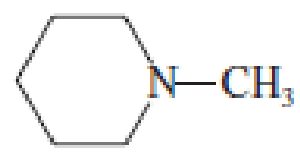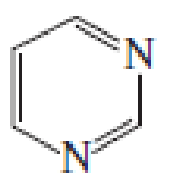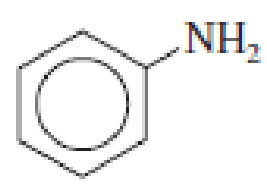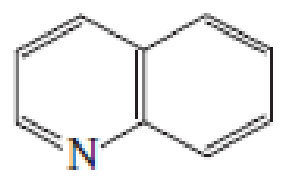
Organic And Biological Chemistry
7th Edition
ISBN: 9781305081079
Author: STOKER, H. Stephen (howard Stephen)
Publisher: Cengage Learning,
expand_more
expand_more
format_list_bulleted
Concept explainers
Textbook Question
Chapter 6, Problem 6.77EP
Indicate whether or not each of the following compounds is a heterocyclic




Expert Solution & Answer
Trending nowThis is a popular solution!

Students have asked these similar questions
Among the methods for measuring transport numbers are the Hittorf method and the moving surface method. Let's explain them briefly.
can you help me solve and highlight these hw
can you please help me draw these structures for HW
Chapter 6 Solutions
Organic And Biological Chemistry
Ch. 6.1 - Prob. 1QQCh. 6.1 - Prob. 2QQCh. 6.2 - Prob. 1QQCh. 6.2 - Prob. 2QQCh. 6.2 - Prob. 3QQCh. 6.2 - Prob. 4QQCh. 6.3 - Prob. 1QQCh. 6.3 - Prob. 2QQCh. 6.3 - Prob. 3QQCh. 6.3 - Prob. 4QQ
Ch. 6.4 - Prob. 1QQCh. 6.4 - Prob. 2QQCh. 6.5 - Prob. 1QQCh. 6.5 - Prob. 2QQCh. 6.5 - Prob. 3QQCh. 6.6 - Prob. 1QQCh. 6.6 - Prob. 2QQCh. 6.6 - Prob. 3QQCh. 6.7 - Prob. 1QQCh. 6.7 - Prob. 2QQCh. 6.7 - Prob. 3QQCh. 6.8 - Prob. 1QQCh. 6.8 - Prob. 2QQCh. 6.8 - Prob. 3QQCh. 6.8 - Prob. 4QQCh. 6.9 - Prob. 1QQCh. 6.9 - Prob. 2QQCh. 6.10 - Prob. 1QQCh. 6.10 - Prob. 2QQCh. 6.10 - Prob. 3QQCh. 6.10 - Prob. 4QQCh. 6.11 - Prob. 1QQCh. 6.11 - Prob. 2QQCh. 6.11 - Prob. 3QQCh. 6.12 - Prob. 1QQCh. 6.12 - Prob. 2QQCh. 6.12 - Prob. 3QQCh. 6.12 - Prob. 4QQCh. 6.13 - Prob. 1QQCh. 6.13 - Prob. 2QQCh. 6.13 - Prob. 3QQCh. 6.13 - Prob. 4QQCh. 6.14 - Prob. 1QQCh. 6.14 - Prob. 2QQCh. 6.14 - Prob. 3QQCh. 6.15 - Prob. 1QQCh. 6.15 - Prob. 2QQCh. 6.16 - Prob. 1QQCh. 6.16 - Prob. 2QQCh. 6.16 - Prob. 3QQCh. 6.17 - Prob. 1QQCh. 6.17 - Prob. 2QQCh. 6.17 - Prob. 3QQCh. 6.18 - Prob. 1QQCh. 6.18 - Prob. 2QQCh. 6.18 - Prob. 3QQCh. 6.19 - Prob. 1QQCh. 6.19 - Prob. 2QQCh. 6.19 - Prob. 3QQCh. 6.19 - Prob. 4QQCh. 6 - Prob. 6.1EPCh. 6 - Prob. 6.2EPCh. 6 - Prob. 6.3EPCh. 6 - Prob. 6.4EPCh. 6 - Prob. 6.5EPCh. 6 - Prob. 6.6EPCh. 6 - Prob. 6.7EPCh. 6 - Indicate whether or not each of the following...Ch. 6 - Indicate whether each of the compounds in Problem...Ch. 6 - Prob. 6.10EPCh. 6 - Prob. 6.11EPCh. 6 - Prob. 6.12EPCh. 6 - Prob. 6.13EPCh. 6 - Prob. 6.14EPCh. 6 - Prob. 6.15EPCh. 6 - Prob. 6.16EPCh. 6 - Prob. 6.17EPCh. 6 - Assign an IUPAC name to each of the following...Ch. 6 - Prob. 6.19EPCh. 6 - Prob. 6.20EPCh. 6 - Prob. 6.21EPCh. 6 - Prob. 6.22EPCh. 6 - Prob. 6.23EPCh. 6 - Prob. 6.24EPCh. 6 - Prob. 6.25EPCh. 6 - Classify each of the following compounds as a 1...Ch. 6 - Prob. 6.27EPCh. 6 - Prob. 6.28EPCh. 6 - Prob. 6.29EPCh. 6 - Prob. 6.30EPCh. 6 - Prob. 6.31EPCh. 6 - Prob. 6.32EPCh. 6 - Prob. 6.33EPCh. 6 - Prob. 6.34EPCh. 6 - Determine the maximum number of hydrogen bonds...Ch. 6 - Prob. 6.36EPCh. 6 - Although they have similar molecular masses (73...Ch. 6 - Prob. 6.38EPCh. 6 - Prob. 6.39EPCh. 6 - Prob. 6.40EPCh. 6 - Show the structures of the missing substance(s) in...Ch. 6 - Prob. 6.42EPCh. 6 - Prob. 6.43EPCh. 6 - Prob. 6.44EPCh. 6 - Prob. 6.45EPCh. 6 - Prob. 6.46EPCh. 6 - Prob. 6.47EPCh. 6 - Prob. 6.48EPCh. 6 - Prob. 6.49EPCh. 6 - Prob. 6.50EPCh. 6 - Prob. 6.51EPCh. 6 - Prob. 6.52EPCh. 6 - Prob. 6.53EPCh. 6 - Prob. 6.54EPCh. 6 - Prob. 6.55EPCh. 6 - Prob. 6.56EPCh. 6 - Prob. 6.57EPCh. 6 - Prob. 6.58EPCh. 6 - Prob. 6.59EPCh. 6 - Prob. 6.60EPCh. 6 - Prob. 6.61EPCh. 6 - Prob. 6.62EPCh. 6 - Prob. 6.63EPCh. 6 - Prob. 6.64EPCh. 6 - Prob. 6.65EPCh. 6 - Prob. 6.66EPCh. 6 - Prob. 6.67EPCh. 6 - Prob. 6.68EPCh. 6 - Prob. 6.69EPCh. 6 - Prob. 6.70EPCh. 6 - Prob. 6.71EPCh. 6 - Prob. 6.72EPCh. 6 - Prob. 6.73EPCh. 6 - Prob. 6.74EPCh. 6 - Name each of the salts in Problem 17-71. a....Ch. 6 - Prob. 6.76EPCh. 6 - Indicate whether or not each of the following...Ch. 6 - Prob. 6.78EPCh. 6 - Prob. 6.79EPCh. 6 - Prob. 6.80EPCh. 6 - Prob. 6.81EPCh. 6 - Prob. 6.82EPCh. 6 - Prob. 6.83EPCh. 6 - Prob. 6.84EPCh. 6 - Prob. 6.85EPCh. 6 - Prob. 6.86EPCh. 6 - Prob. 6.87EPCh. 6 - Prob. 6.88EPCh. 6 - Prob. 6.89EPCh. 6 - Prob. 6.90EPCh. 6 - Prob. 6.91EPCh. 6 - Indicate whether each of the following statements...Ch. 6 - Prob. 6.93EPCh. 6 - Prob. 6.94EPCh. 6 - Prob. 6.95EPCh. 6 - Prob. 6.96EPCh. 6 - Prob. 6.97EPCh. 6 - Prob. 6.98EPCh. 6 - Indicate whether or not each of the following...Ch. 6 - Prob. 6.100EPCh. 6 - Classify each of the following amides as...Ch. 6 - Classify each of the following amides as...Ch. 6 - Prob. 6.103EPCh. 6 - Prob. 6.104EPCh. 6 - Prob. 6.105EPCh. 6 - Prob. 6.106EPCh. 6 - Prob. 6.107EPCh. 6 - Assign an IUPAC name to each of the following...Ch. 6 - Prob. 6.109EPCh. 6 - Prob. 6.110EPCh. 6 - Prob. 6.111EPCh. 6 - Prob. 6.112EPCh. 6 - Prob. 6.113EPCh. 6 - Prob. 6.114EPCh. 6 - Prob. 6.115EPCh. 6 - Prob. 6.116EPCh. 6 - Prob. 6.117EPCh. 6 - Prob. 6.118EPCh. 6 - Prob. 6.119EPCh. 6 - Prob. 6.120EPCh. 6 - Prob. 6.121EPCh. 6 - Prob. 6.122EPCh. 6 - Prob. 6.123EPCh. 6 - Prob. 6.124EPCh. 6 - Prob. 6.125EPCh. 6 - Prob. 6.126EPCh. 6 - Prob. 6.127EPCh. 6 - Prob. 6.128EPCh. 6 - Prob. 6.129EPCh. 6 - Prob. 6.130EPCh. 6 - Prob. 6.131EPCh. 6 - Prob. 6.132EPCh. 6 - Prob. 6.133EPCh. 6 - Prob. 6.134EPCh. 6 - Prob. 6.135EPCh. 6 - Prob. 6.136EPCh. 6 - Prob. 6.137EPCh. 6 - Prob. 6.138EPCh. 6 - Prob. 6.139EPCh. 6 - Prob. 6.140EPCh. 6 - Prob. 6.141EPCh. 6 - Prob. 6.142EPCh. 6 - Prob. 6.143EPCh. 6 - Prob. 6.144EPCh. 6 - Prob. 6.145EPCh. 6 - Draw the structure of the nitrogen-containing...Ch. 6 - Prob. 6.147EPCh. 6 - Prob. 6.148EPCh. 6 - Prob. 6.149EPCh. 6 - Prob. 6.150EPCh. 6 - Prob. 6.151EPCh. 6 - Prob. 6.152EPCh. 6 - Prob. 6.153EPCh. 6 - Prob. 6.154EP
Knowledge Booster
Learn more about
Need a deep-dive on the concept behind this application? Look no further. Learn more about this topic, chemistry and related others by exploring similar questions and additional content below.Similar questions
- please solvearrow_forwardplease help with synthesisarrow_forward10. Stereochemistry. Assign R/S stereochemistry for the chiral center indicated on the following compound. In order to recieve full credit, you MUST SHOW YOUR WORK! H₂N CI OH CI カー 11. () Stereochemistry. Draw all possible stereoisomers of the following compound. Assign R/S configurations for all stereoisomers and indicate the relationship between each as enantiomer, diastereomer, or meso. NH2 H HNH, -18arrow_forward
- b) 8. Indicate whether the following carbocation rearrangements are likely to occur Please explain your rational using 10 words or less not likely to occur • The double bond is still in the Same position + Likely to oc occur WHY? -3 H3C Brave Chair Conformers. Draw the chair conformer of the following substituted cyclohexane. Peform a RING FLIP and indicate the most stable conformation and briefly explain why using 20 words or less. CI 2 -cobs ?? MUST INDICATE H -2 -2 Br EQ Cl OR AT Br H& most stable WHY? - 4arrow_forwardCH 12 Conformational Analysis. Draw all 6 conformers (one above each letter) of the compound below looking down the indicated bond. Write the letter of the conformer with the HIGHEST and LOWEST in energies on the lines provided. NOTE: Conformer A MUST be the specific conformer of the structure as drawn below -4 NOT HOH OH 3 Conformer A: Br OH A Samo Br H 04 Br H H3 CH₂ H anti stagere Br CH clipsed H Brott H IV H MISSING 2 -2 B C D E F X 6 Conformer with HIGHEST ENERGY: 13. (1 structure LOWEST ENERGY: Nomenclature. a) Give the systematic (IUPAC) name structure. b) Draw the corresponding to this name. HINT: Do not forget to indicate stereochemistry when applicable. a) ८८ 2 "Br {t༐B,gt)-bemn€-nehpརི་ཚ༐lnoa Parent name (noname) 4 Bromo Sub = 2-methylethyl-4 Bromo nonane b) (3R,4S)-3-chloro-4-ethyl-2,7-dimethyloctane # -2 -2arrow_forwardin the scope of the SCH4U course! please show all steps as im still learning how to format my answers in the format given, thank you!arrow_forward
- help me solve this HWarrow_forwardMolecules of the form AH2 can exist in two potential geometries: linear or bent. Construct molecular orbital diagrams for linear and bent CH2. Identify the relevant point group, include all of the appropriate symmetry labels and pictures, and fill in the electrons. Which geometry would you predict to be more stable, and why? (Please draw out the diagram and explain)arrow_forwardIndicate the variation in conductivity with concentration in solutions of strong electrolytes and weak electrolytes.arrow_forward
arrow_back_ios
SEE MORE QUESTIONS
arrow_forward_ios
Recommended textbooks for you
 General, Organic, and Biological ChemistryChemistryISBN:9781285853918Author:H. Stephen StokerPublisher:Cengage Learning
General, Organic, and Biological ChemistryChemistryISBN:9781285853918Author:H. Stephen StokerPublisher:Cengage Learning Organic And Biological ChemistryChemistryISBN:9781305081079Author:STOKER, H. Stephen (howard Stephen)Publisher:Cengage Learning,
Organic And Biological ChemistryChemistryISBN:9781305081079Author:STOKER, H. Stephen (howard Stephen)Publisher:Cengage Learning, Chemistry for Today: General, Organic, and Bioche...ChemistryISBN:9781305960060Author:Spencer L. Seager, Michael R. Slabaugh, Maren S. HansenPublisher:Cengage Learning
Chemistry for Today: General, Organic, and Bioche...ChemistryISBN:9781305960060Author:Spencer L. Seager, Michael R. Slabaugh, Maren S. HansenPublisher:Cengage Learning Chemistry: The Molecular ScienceChemistryISBN:9781285199047Author:John W. Moore, Conrad L. StanitskiPublisher:Cengage Learning
Chemistry: The Molecular ScienceChemistryISBN:9781285199047Author:John W. Moore, Conrad L. StanitskiPublisher:Cengage Learning

General, Organic, and Biological Chemistry
Chemistry
ISBN:9781285853918
Author:H. Stephen Stoker
Publisher:Cengage Learning

Organic And Biological Chemistry
Chemistry
ISBN:9781305081079
Author:STOKER, H. Stephen (howard Stephen)
Publisher:Cengage Learning,

Chemistry for Today: General, Organic, and Bioche...
Chemistry
ISBN:9781305960060
Author:Spencer L. Seager, Michael R. Slabaugh, Maren S. Hansen
Publisher:Cengage Learning

Chemistry: The Molecular Science
Chemistry
ISBN:9781285199047
Author:John W. Moore, Conrad L. Stanitski
Publisher:Cengage Learning
Nomenclature: Crash Course Chemistry #44; Author: CrashCourse;https://www.youtube.com/watch?v=U7wavimfNFE;License: Standard YouTube License, CC-BY